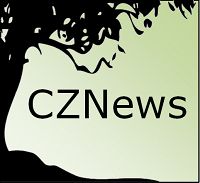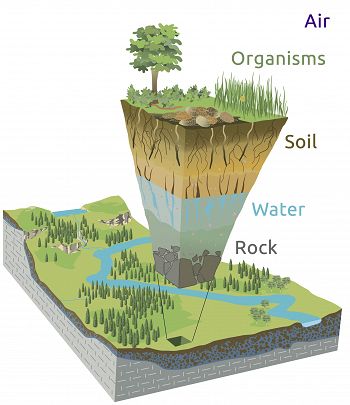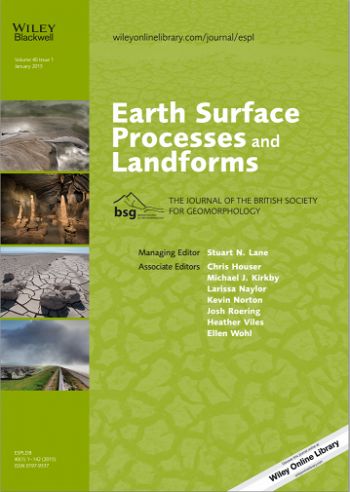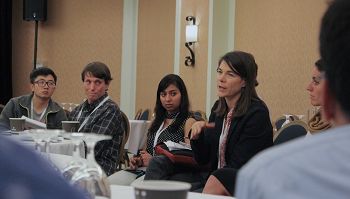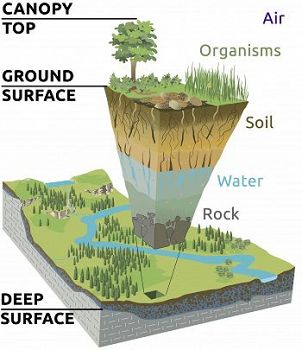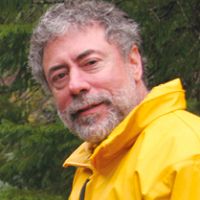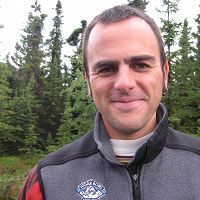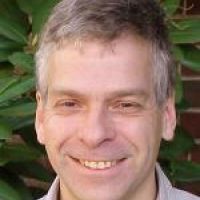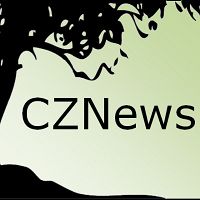CZNews: Summer 2017
Print Verison: CZNews - Summer 2017 (1 MB PDF)
A new generation of CZ scientists
A commentary on the emerging generation of CZ scientists trained through the CZO program has been published by Adam Wymore (University of New Hampshire) et al. in Earth Surface Processes and Landforms (2017). In “Growing new generations of critical zone scientists” the authors outline five scientific challenges of CZ science for early career CZ researchers to target: 1) understanding water availability in the CZ; 2) expanding CZ science into new landscapes and environments; 3) communicating the societal relevance of CZ science to the public; 4) integrating biological sciences within the CZ framework; 5) and scaling CZ processes over large spatial and temporal gradients. These challenges provide a framework for former CZ science students, many of whom are now early career researchers across universities, to move CZ science forward as it enters its second decade. Such researchers hold a pivotal role in the promotion and training of future CZ scientists. Important steps towards this effort include incorporating CZ concepts into current educational curriculum, taking advantage of funding sources that support large collaborative research, and collaborating with the broader Earth surface and environmental science research community.
Arlington Meeting for Critical Zone science
The CZO community thanks all those who participated in the meeting hosted by the CZO network, “Critical Zone Science: Current Advances & Future Opportunities,” held June 4-6 in Arlington, VA. The meeting began with an introduction to the U.S. CZO program from CZO NSF program director Richard Yuretich, followed by a plenary address, “Perspectives on CZ Science”, by Susquehanna Shale Hills PI Susan Brantley (Penn State). The meeting agenda included many scientific talks, two poster sessions, a panel discussion on building cross-network observatory opportunities, and two breakout sessions among 200 participants. You can find the full list of talks and poster abstracts at criticalzone.org/national/events/event/2017-06-04-2017-arlington-meeting-for-critical-zone-science/. Five breakout groups met to address compelling research questions in CZ science, the future of observatories and networks, and CZ educational initiatives. Input from these discussions will be coalesced into a white paper. To further explore the meeting theme, a discussion paper entitled “Designing a network of critical zone observatories to explore the living skin of the terrestrial Earth” by Brantley, et al. has been published in Earth Surface Dynamics (July 2017). This paper is open for comment until July 31st and can be found here.
Events
- Goldschmidt 2017 Conference, August 13-18, Paris, France
- CZO PI Meeting, September 8-11, Eel River CZO, CA
- ILTER & LTER-France joint conference, October 2-4, Nantes, France
- GSA 2017 Annual Meeting, October 22-25, Seattle, WA
- AGU Fall Meeting 2017, December 11-15, New Orleans, LA
CZO Spotlight: Gordon Grant
Gordon Grant, a research hydrologist with the U.S. Forest Service’s (USFS) Pacific Northwest Research Station, has served as chair for the U.S. CZO Program’s Steering Committee since 2010. Gordon’s commitment to the CZOs has shown through by his invaluable guidance, his stand out participation and voice for the CZO community, and his research contribution to understanding the CZ. Gordon began his time with the USFS shortly before he received his Ph.D. in geomorphology from Johns Hopkins University in 1986. His 12-year career as a whitewater river guide led to a fascination with rivers, and his research has focused on the geomorphic response of rivers to changes in flow and sediment transport due to land use, dams and dam removal, volcanic eruptions, and climate change. Grant’s work has played an enormous role in developing watershed perspectives for managing public lands, and for this, he became the first USFS researcher in the program’s 54-year-history to be named a Fellow of the American Geophysical Union in 2016. Grant is also a Courtesy Professor in the College of Earth, Ocean, and Atmospheric Sciences at Oregon State University and serves on the board of directors of the Consortium of Universities for the Advancement of Hydrologic Sciences (CUAHSI). We appreciate Gordon’s continued dedication to the CZO program and CZ science!
NSF Discoveries
The National Science Foundation’s Discoveries are feature articles about NSF-supported research, researchers, research results and the impacts of those results. The current 16-part series on the Critical Zone Observatories can be found at nsf.gov. The latest of the series, “Can an ancient ocean shoreline set the stage for a tropical forest of today?” describes a research effort between the Luquillo CZO and LTER in Puerto Rico where researchers are working to determine how the formation of the Luquillo Mountains and their subsequent weathering resulted in today's Luquillo rainforest ecosystem. The geologic history of Puerto Rico transformed a previously low-elevation island and its surrounding marine platform into the mountainous landscape observed today. Using LiDAR, scientists discovered a 10-meter (33-foot) decline in forest height across an ancient shoreline, but only where rocks were formed of hard quartz diorite. Soils there are shallow so trees have difficulty finding stability and nutrients, and therefore do not grow as high. In addition, researchers found that changes in forest composition occur at knickpoints, sharp changes in river drainage slope. The differences in soil nutrients above and below knickpoints are influenced by the bedrock beneath and could be a reason for the different forest heights. This research has brought new understanding of the role of geology in structuring the forest ecosystem of the Luquillo Mountains.
Key Findings of the CZO Network
Key findings about the Critical Zone have emerged from the CZO network from studies spanning its environmental range. The findings reflect the Critical Zone’s three dynamic and spatially structured co-evolving surfaces: the top of the vegetation canopy, the ground surface, and a third, deep surface below which Earth materials are unweathered. For the first time, the CZO network has obtained observations from drilling and geophysical methods that reveal how the deep surface of the Critical Zone varies across landscapes [See Holbrook, et al. (2014) and Olyphant, et al. (2016)]. New mechanistic models across the network now provide quantitative predictions of the spatial structure of the deep surface relative to the ground surface topography [See Anderson, R.S. (2015) and St. Clair, et al (2015)]. Also for the first time, the network has obtained observations that reveal that differences in energy inputs at Earth’s surface translate into differences in water, minerals, and biotic activity at depth, and we are starting to detect how these deep properties also impact the biota and climate [See Hinckley, et al. (2014) and Stone, et al. (2014)]. Find a complete list of the CZO publications that contributed to these findings.
CZNews
Receive the CZO Email Newsletter
Occasional email will include news, events, and other info related to Critical Zone Observatories.
We hate spam as much as you do, so your information will never be shared. You can unsubscribe at any time.
Earth Surface Processes and Landforms
Kathleen Lohse, Reynolds Creek CZO PI, speaks to during a breakout group session.
Panel discussion at the CZO Arlington Meeting. The panel (left to right): Diane McKnight (NSF GEO), John Schade (NSF BIO), Elisabeth Bui (ILTER &ICZO), Gene Kelly (NEON), David Lesmes (DOE), Richard Yuretich (NSF), Lindsey Rustad (USFS), Lou Kaplan (NSF DEB) and William McDowell (UNH)
Elisabeth Bui -ILTER &ICZO
Gordon Grant
Water flows along what scientists call a knickpoint: a change in the slope of a river.
Credit: Gilles Brocard/ Source: NSF
"Modified from Chorover, J., R. Kretzschmar, F. Garcia-Pichel, and D. L. Sparks. 2007. Soil biogeochemical processes in the critical zone. Elements 3, 321-326. (artwork by R. Kindlimann).
"Modified from Chorover, J., R. Kretzschmar, F. Garcia-Pichel, and D. L. Sparks. 2007. Soil biogeochemical processes in the critical zone. Elements 3, 321-326. (artwork by R. Kindlimann).
News Category:
EDUCATION/OUTREACH
People Involved
CZO
-
National, ADVISORY BOARD
-
Luquillo, INVESTIGATOR
-
National, NATIONAL SCIENCE FOUNDATION
-
National, Eel, Luquillo, Shale Hills, INVESTIGATOR, COLLABORATOR
Explore Further
